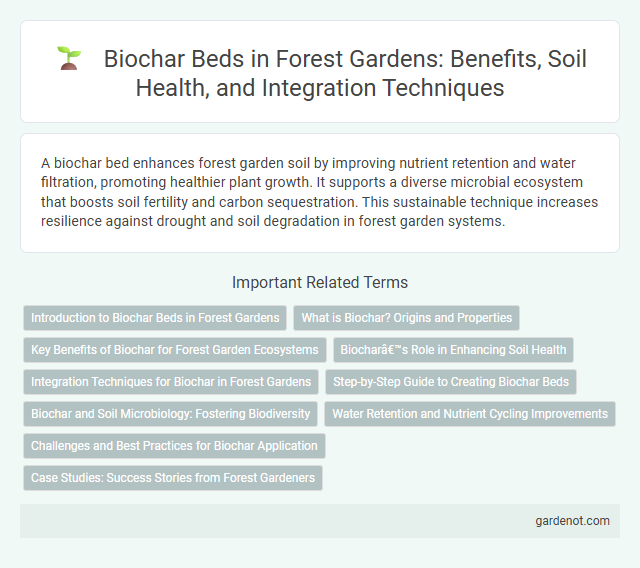A biochar bed enhances forest garden soil by improving nutrient retention and water filtration, promoting healthier plant growth. It supports a diverse microbial ecosystem that boosts soil fertility and carbon sequestration. This sustainable technique increases resilience against drought and soil degradation in forest garden systems.
Introduction to Biochar Beds in Forest Gardens
Biochar beds in forest gardens enhance soil fertility by improving nutrient retention and promoting beneficial microbial activity. This method involves incorporating biochar, a stable form of carbon, into garden beds to increase water holding capacity and reduce soil acidity. Using biochar beds creates a sustainable growing environment that boosts plant health and productivity over time.
What is Biochar? Origins and Properties
Biochar is a carbon-rich product obtained through the pyrolysis of organic materials, such as wood or crop residues, in a low-oxygen environment. Originating from ancient indigenous practices like Terra Preta soil amendments in the Amazon Basin, biochar enhances soil fertility and carbon sequestration. Its porous structure improves water retention, nutrient availability, and microbial activity, making it a valuable component in forest garden biochar beds.
Key Benefits of Biochar for Forest Garden Ecosystems
Biochar enhances soil structure and nutrient retention, promoting healthier root systems in forest garden ecosystems. It supports beneficial microbial activity that boosts plant growth and resilience against pests and diseases. The increased carbon sequestration capacity of biochar also contributes to long-term climate regulation within the garden environment.
Biochar’s Role in Enhancing Soil Health
Biochar improves soil health by increasing nutrient retention, enhancing microbial activity, and boosting water-holding capacity in forest garden beds. Its porous structure supports beneficial microorganisms, promoting a balanced ecosystem for root development and plant growth. Incorporating biochar into soil reduces nutrient leaching and improves soil structure, leading to sustainable fertility and increased resilience against environmental stress.
Integration Techniques for Biochar in Forest Gardens
In forest gardens, integrating biochar enhances soil fertility and moisture retention by improving microbial activity and nutrient availability. Techniques such as mixing biochar with compost or applying it in planting holes ensure better assimilation into soil ecosystems. This strategic incorporation supports diverse plant growth and long-term ecosystem resilience.
Step-by-Step Guide to Creating Biochar Beds
Creating biochar beds involves several precise steps to enhance soil fertility and carbon sequestration effectively. Begin by producing biochar through pyrolysis of organic material, ensuring it is cooled and cured before application; then mix the biochar with compost or nutrient-rich organic matter to promote microbial activity. Finally, spread the mixture evenly over the garden bed, incorporate it into the topsoil, and maintain consistent moisture to support plant growth and soil health.
Biochar and Soil Microbiology: Fostering Biodiversity
Biochar enhances soil microbiology by providing a stable habitat for diverse microbial communities, which boost nutrient cycling and improve soil fertility. Its porous structure increases oxygen retention and water availability, creating favorable conditions for beneficial bacteria and fungi to thrive. Incorporating biochar into forest garden beds fosters biodiversity, leading to resilient ecosystems and healthier plant growth.
Water Retention and Nutrient Cycling Improvements
Biochar beds significantly enhance water retention in forest gardens by increasing soil porosity and moisture-holding capacity, reducing irrigation needs. Their porous structure also promotes beneficial microbial activity, accelerating nutrient cycling and improving soil fertility. This results in healthier plant growth and more resilient ecosystems within forest garden systems.
Challenges and Best Practices for Biochar Application
Biochar application in forest garden beds faces challenges such as uneven nutrient distribution and potential soil pH imbalance, which can hinder plant growth. Best practices include thoroughly mixing biochar with compost to enhance nutrient retention, applying biochar in moderate quantities to prevent soil alkalinity, and pre-charging it with nutrients before incorporation. Regular soil testing and monitoring help optimize biochar benefits and maintain soil health in forest garden systems.
Case Studies: Success Stories from Forest Gardeners
Biochar beds have transformed soil fertility and water retention in multiple forest garden case studies, demonstrating significant increases in plant growth and resilience. In a temperate forest garden, biochar application led to a 40% boost in fruit yield and enhanced microbial diversity, promoting sustainable ecosystem health. These success stories highlight biochar's role in carbon sequestration and long-term soil revitalization within diverse permaculture systems.
Biochar bed Infographic

 gardenot.com
gardenot.com